List of Authors
>>About this blog
Recent blog post
|
[Minato kid]
May 25, 2018 14:00
In Chuo-ku, there are 98 routes that are familiar to the local community and have nicknames. There are stories on every path, and they tell us with various expressions. And in fact, roads without nicknames are packed with many charms. Today, I would like to spotlight on such a casual road.
♪ A retro road under high speed
This is the road ahead of Ginza 1-17, "Kibikicho Nakadori" begins. I don't have a nickname. If you dare to say it, Special Metropolitan Route 451. There is a Ginza 1-chome parking lot at the Metropolitan Expressway, and next to it is the Kyobashi fire department. It is a quiet road just one from Showa-dori, but there are many cars and traffic, making it an indispensable road for daily life.
The Kyobashi River is an approximately 600m waterway excavated from outer moat to Kaede River during the Keicho era of the Edo period. As part of the post-war reconstruction project, landfill began in 1954 (1954), and disappeared in 1959 (1959). There must have been a white fish bridge around here. Now the highway crosses overhead to create a shade.

This Ginza 1-chome parking lot is entirely bricked. It has a somewhat nostalgic atmosphere. There is a resident, and there is a place where eyes meet unintentionally through a large window, and there is something humanity. There is a small planting beside the sidewalk, and flowers are blooming. Surrounded by the noise of concrete and cars, the small flowers convey the season well.

The next Kyobashi fire truck has a different address and will be Kyobashi 3-chome 14. If you look into the gap between the Ginza 1-chome parking lot, the other side of the street has a steeply subducted terrain, and you can see cars going through the former Kaede River at a high speed. There were cute flowers in the planting of the entrance. And Kuta-kun is posing. In addition, there is also a mini curve mirror for Cuta, which is cute.
♪ Automatic telephone exchange launch site
On the other side of the Ginza 1-chome parking lot is already Kibikicho Nakadori. I meet a big building in Seiko Watch. When I turned around the corner and turned toward Shinkinbashi, I found a monument to "Automatic Telephone Exchange Shonochi" in the planting on the premises. There is this in the monument.
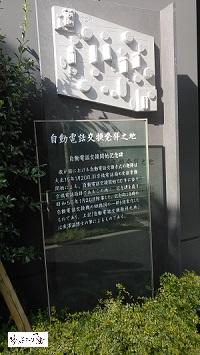 ― The automatic telephone exchange system in Japan originated on January 20, 1926, when the exchange service of the former Kyobashi telephone office began. In the 50th anniversary of the start of automatic telephone exchange, a monument was built in this area, the site of the Kyobashi telephone station, and unveiled on January 20, 1975. The monument is a stylized part of the circuit diagram of the automatic telephone exchange machine at that time, and the "automatic telephone exchange launch site" is written by Dr. Shigeru Yonezawa.― ― The automatic telephone exchange system in Japan originated on January 20, 1926, when the exchange service of the former Kyobashi telephone office began. In the 50th anniversary of the start of automatic telephone exchange, a monument was built in this area, the site of the Kyobashi telephone station, and unveiled on January 20, 1975. The monument is a stylized part of the circuit diagram of the automatic telephone exchange machine at that time, and the "automatic telephone exchange launch site" is written by Dr. Shigeru Yonezawa.―
(1-26-1 Ginza, Chuo-ku, Tokyo)
In 1975 (1975), when this monument was unveiled, the building called Hotel Ginza Laffinate (formerly Kyobashi Kaikan) was built here. At that time, I saw a larger schematic on the outer wall of the entrance. The Seiko Watch building was built in May 2016 (May 2016). I think this monument was also newly rebuilt in line with it. Right now, the NTT East Kyobashi Building is located in Ginza 2-chome. If you look at it in this way, there is an irreplaceable "Ayumi" on the unnamed road. That's why the sidewalk in Chuo-ku is interesting! I think so.
Chuo-ku Tourism correspondent Minatokko-chan

No. 11 May 20, 2018
[Minato kid]
May 23, 2018 18:00
Koji Ogawa was born in Minatomachi, Chuo-ku (currently Minato) in 1948 (1948). From 1976 (1976), he began sketching in Chuo-ku with the desire to keep the old cityscape. Ogawa's gaze is not only famous buildings, but also in casual alleys and street corners.
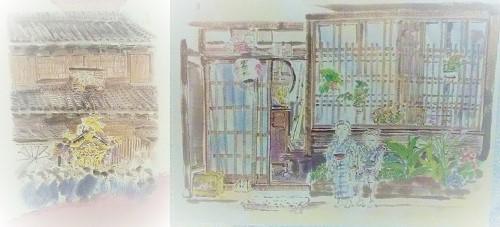
― I was born and raised in Minato, a gunshot in Chuo-ku, Tokyo. The birthplace was a "Shimotaya" with a lattice bay window. "Ogawa's neighborhood has a lot of interesting houses." When I was told by a classmate at Geidai, I realized that it was a unique and harmonious cityscape with a copper-covered store, a pushshibushi tenement shop, a girder shop, a relief and colorful tiled house. I reconfirmed that, but I was born and raised in that, thought it was natural. (Same as below from the special exhibition booklet)―
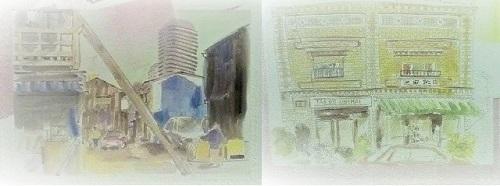 ― In 1976, with the rebuilding of my old home, I went from the neighboring houses to Nihonbashi and Ginza, and started drawing a city of memories. Occasionally, land prices have risen in Tokyo, and the streets that grew up with my grandfather, father and me for three generations have been raised one after another under redevelopment, and the familiar scenery and moist daily life since childhood have disappeared. I have done it. At that time, I began to feel a strong sense of crisis and a sense of mission.― ― In 1976, with the rebuilding of my old home, I went from the neighboring houses to Nihonbashi and Ginza, and started drawing a city of memories. Occasionally, land prices have risen in Tokyo, and the streets that grew up with my grandfather, father and me for three generations have been raised one after another under redevelopment, and the familiar scenery and moist daily life since childhood have disappeared. I have done it. At that time, I began to feel a strong sense of crisis and a sense of mission.―
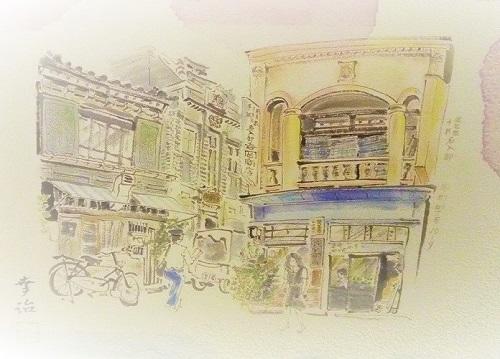
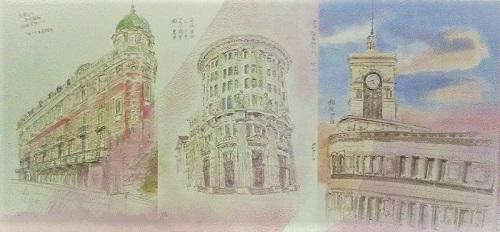
― The bustle of Ginza, the fish shore of Tsukiji, modern downtown, alley planting, and long-established Nihonbashi. The historical city has its own taste. When I heard about the rebuilding of Theatre Tokyo, Niski, Tokyo Stock Exchange, etc., I went there early and started sketching.―
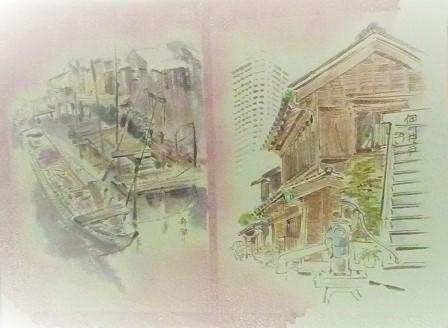
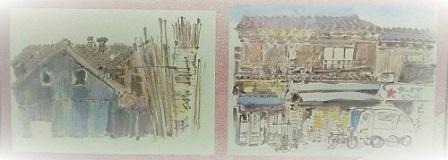
― The three major changes in the city of Tokyo were the Great Kanto Earthquake, World War II, and the rising whirlwind. The city of Tokyo is too wide and has a lot of problems and is very interesting.―

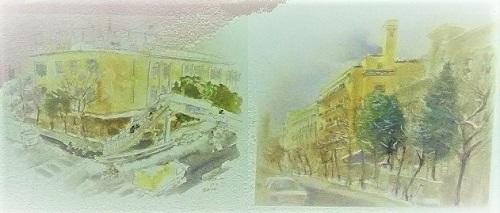
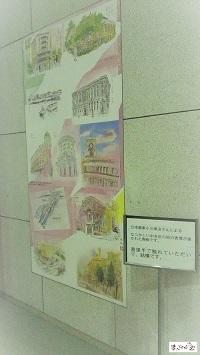 Koji Ogawa's words included in the booklet of "Ginza, Tsukuda, Nihonbashi at the end of the 20th century special exhibition Koji Ogawa's Tokyo painting" held in October 2007 at Time Dome Akashi, Chuo Ward Local Tenmonkan. At the end of the 20th century, from Showa to Heisei, it was a time when Tokyo changed drastically. And in the 21st century, Tokyo continues to carve a new time. Koji Ogawa's words included in the booklet of "Ginza, Tsukuda, Nihonbashi at the end of the 20th century special exhibition Koji Ogawa's Tokyo painting" held in October 2007 at Time Dome Akashi, Chuo Ward Local Tenmonkan. At the end of the 20th century, from Showa to Heisei, it was a time when Tokyo changed drastically. And in the 21st century, Tokyo continues to carve a new time.
Ogawa's work can be seen in the free space at the entrance on the first floor of the building of Rainbow House Akashi. It is printed directly on a stone wall and tells us about the good old streets. (I took a picture of the work here.)
Chuo-ku Tourism correspondent Minatokko-chan

No. 10 May 19, 2018
[Dimini ☆ Cricket]
May 22, 2018 12:00
The hydrangea season begins.
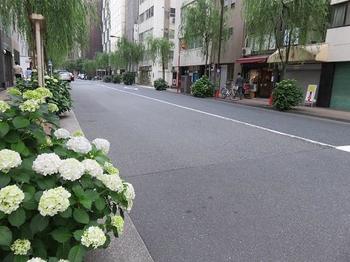
On the map below, the street from Showa-dori to Miyoshi Bridge (blue part), there are many kinds of hydrangeas planted, each of which is beginning to bloom.
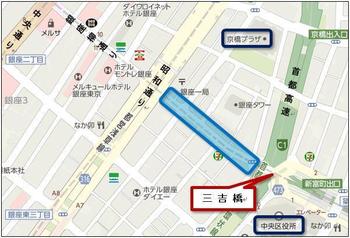
Hydrangea (hydrangea) is a deciduous shrub of the Hydrangea family Hydrangea.
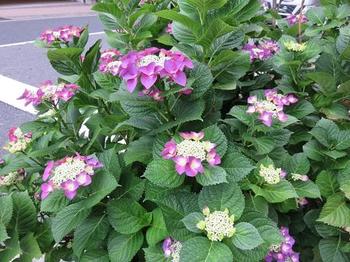
It is widely cultivated for ornamental use in Japan, Western Europe, the United States, etc., and many varieties are produced.
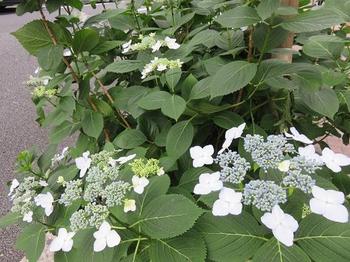
Hydrangea ancestor is a bigleaf hydrangea native to Japan, which is lined up around the inflorescence, and is called "forehead bloom" in horticulture. native to Japan, which is lined up around the inflorescence, and is called "forehead bloom" in horticulture.
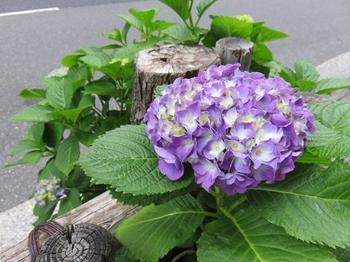
Hydrangea, which has changed from bigleaf hydrangea and has a spherical inflorescence and has all become ornamental flower, is called "temari bloom". 
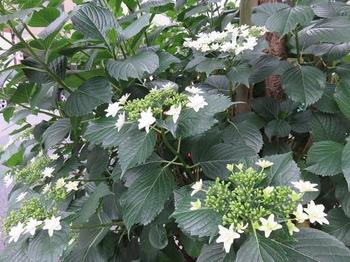
In this street, there are bigleaf hydrangea and temari blooming hydrangea, as well as Kashiwaba hydrangea with conical inflorescences and leaves similar to Kashiwa-no-ha. with conical inflorescences and leaves similar to Kashiwa-no-ha.

Hydrangea has a good flowery and can be enjoyed for a long time, but the part that looks like a hydrangea flower is not a petal, but a calyx.
One of the ways to enjoy hydrangea is that you can enjoy the color of this calyx slightly changes.
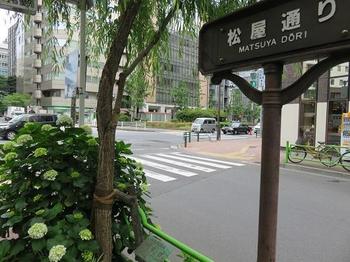
Hydrangea on Matsuya-dori is also beginning to bloom.
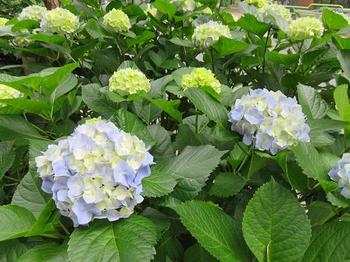
In addition to these streets, many streets in Chuo-ku, you can enjoy hydrangea in the park.
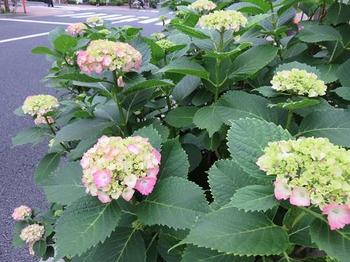
Here is a blog that introduces hydrangeas that are blooming in the same street two years ago. ⇒
/archive/2016/06/post-3392.html
        
[Minato kid]
May 22, 2018 09:00
There are a lot of nice sidewalks in Chuo-ku. Above all, the sidewalk with pictures showing the characteristics of the town is charming and very interesting. I would like to introduce you to such a unique sidewalk.
♪ Welcome to the sidewalk museum!

This is the sidewalk at the base of Miyoshibashi in front of Chuo-ku government office. The picture of Miyoshi Bridge is drawn. In the picture, there are several trees in the distance. I think this is a scenery overlooking Miyoshi Bridge from the ward office. It is also the scenery of the time when the river was still flowing. Looking at the photos of 1930, the same outdoor light and protective fence were shown as those currently standing on Miyoshi Bridge. At that time, the ward office building also had a rounded retro atmosphere.

This is the sidewalk with a picture of Miyoshi Bridge toward Ginza. The street address is drawn. But was there any construction of the sidewalk that was missing? I feel the pride of the local people in "My town" in drawing the town name as a character instead of a picture.
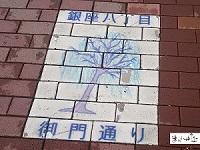
It's "Mimon-dori" at 8-chome in Ginza. It was the place where Shibakuchi Gomon was built in 1710. It is Kitazume in Shimbashi, which now runs over the former Shiodome River, where the highway runs. Nearby, there was also a figure of Yanagi Shisei in Ginza.
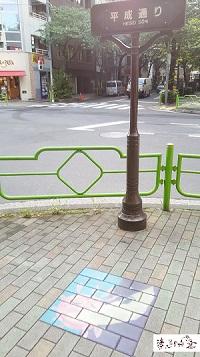 This is a picture I found on the sidewalk of Heisei-dori. The moon and the sun. I also checked the nearby sidewalk, but this was the only place where there was a picture. Who painted this pretty cute picture? There is Sakamoto Elementary School nearby, so it may be a student's work. This is a picture I found on the sidewalk of Heisei-dori. The moon and the sun. I also checked the nearby sidewalk, but this was the only place where there was a picture. Who painted this pretty cute picture? There is Sakamoto Elementary School nearby, so it may be a student's work.
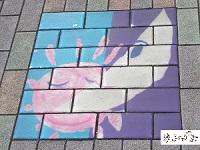

Well, I found such a small manhole. The flower azalea of the ward and the tree and eel of the ward are drawn. And the word "light". This seems to contain the wiring of streetlights. I was impressed by the vivid colors and the pictures and letters lined up in a small circle. Minato kid found this manhole under Takahashi over the Kamejima River, Minato 1-chome side, and then Akashicho. In addition, there seems to be a different color, so I would like to look for it.
♪ There seems to be still a nice sidewalk.
Chuo-ku Tourism correspondent Minatokko-chan

No. 9 May 18, 2018
[Sam]
May 21, 2018 09:00
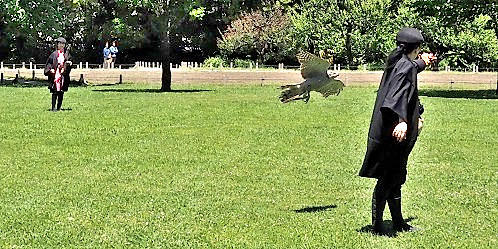 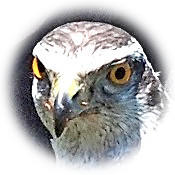 In the Edo period, the restoration and maintenance work of "Hawk's Ochiya" in the Hamarikyu Onshi Garden, which was used as a waiting and resting place during falconry, was completed, and internal release was started on April 20. On May 20, one month of the opening, the "Hawk's Ochiya Opening Memorial Project" was held at Uchihakushobori Square as part of the demonstration. In the Edo period, the restoration and maintenance work of "Hawk's Ochiya" in the Hamarikyu Onshi Garden, which was used as a waiting and resting place during falconry, was completed, and internal release was started on April 20. On May 20, one month of the opening, the "Hawk's Ochiya Opening Memorial Project" was held at Uchihakushobori Square as part of the demonstration.
(12:00~ 14:30~)
A performance of "Suwa-ryu" hawk art, which is considered to be one of the groups of falconers held by the Shogun family in the Edo period.
A falconer puts a hawk on a fist and turns around in front of the spectators, a `` transfer '' that jumps from a falconer's fist to another falconer's fist, and a `` migration '' that moves the tree branches and falconers' fists back and forth. Was shown.
At the time of the commemorative photo, the eye strength of northern goshawk in raptor is truly impressive.
[Minato kid]
May 20, 2018 09:00
In Chuo-ku, 98 routes are nicknamed in the hope that it will be an easy-to-understand and familiar road for residents. Today, we will walk along the Kyobashi district "Tegunsu-dori".

`` Tepposu-dori '', nicknamed in 1989, is 3-chome Minato, where you meet Tsukuda-ohashi Bridge, from the base of `` Takahashi '' over the Kamejima River at 4-14 Hatchobori, passing through Minato 1-chome and 2-chome. It is about 600m journey up to 11th. Both the Metropolitan Bus and the Edo Bus have two stops, "Tetsugunsu" and "Minato 3-chome", and are popular with locals under the name of "Bus Street". Along the street, there are Tepposu Inari Shrine and Tepposu Children's Park.

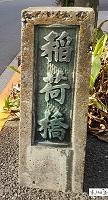 ♪ Sakuragawa ♪ Sakuragawa
In fact, there was a deep connection with this "Tegunsu Street", two rivers that are no longer available now. On the sidewalk between "Takahashi" and "Minami Takahashi", a main pillar with "Inaribashi" remains. This is a remnant of Hatchobori, which once flowed here.
"Hatchobori" was excavated in the early Edo period from the Kyobashi River to the Sumida River for the purpose of shipping, and was named because it was Hatcho (about 872m) in length. In the Meiji era, the name was changed to "Sakuragawa", and in 1986, the landfill of the entire area was completed and disappeared. Minami Takahashi was built over the Kamejima River in 1932, but until then, Inari Bridge overlooked the Sumida River. In addition, "Inari" refers to the gunpowder Inari Shrine, and until the Meiji era was transferred to the current location, the god of water was just watching the safety of the voyage from the water gate "Minato". .
♪ Tepposu River
And another river, "Tepposu River." This river was just flowing through the gunpowder street. This river, which extends from the current Akashicho Akatsuki Park and the former Akashibori, passed through the gunpowder street, turned around the alley located at the border between Minato 2-chome and 3-chome, and poured straight into the Sumida River.

At present, it seems that a gunshot bridge was built around Minatomachi Daiichi Children's Amusement Park. This gunshot river was reclaimed in 1929 as part of the reconstruction of the earthquake. Unfortunately, there is nothing left that can sneak at that time, but the only alley that extends from Teppozu Street to Minatomachi Daiichi Children's Amusement Park may be a remnant of the estuary.
♪ Hydrophilic space

On the sidewalk of Teppozu Street, there is a hydrophilic space along the Kamejima River. The bench installed here is made of thinned wood generated in the forest of Chuo-ku. The Chuo-ku Forest project was launched in October 2006 with a forest area of about 37.4 ha with the NPO Satoyama Reseijuku and forest owners in Hinohara-mura, Nishitama-gun, Tokyo, with the theme of "A beautiful earth for future children." We have concluded an agreement on forest conservation, and are working on global warming countermeasures across regions.
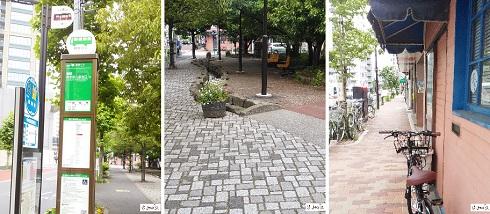
"Tegunsu Street" is a street with very beautiful street trees. The grown platanus grows bright young leaves, and the orange road continues at the feet. There is a small waterside and a fountain in the gunshot children's park along the sidewalk. In the afternoon, the sunbeams are brilliant and dazzling, and the children's cheerful voices are heard. Along the street, old shops create a lively atmosphere, and you can see scenes where nearby residents, office workers, and taxi drivers take a break. It is such a "Tegunsu-dori" where time flows slowly.
Chuo-ku Tourism correspondent Minatokko-chan

No. 8 May 17, 2018
|
Links
|


 ― The automatic telephone exchange system in Japan originated on January 20, 1926, when the exchange service of the former Kyobashi telephone office began. In the 50th anniversary of the start of automatic telephone exchange, a monument was built in this area, the site of the Kyobashi telephone station, and unveiled on January 20, 1975. The monument is a stylized part of the circuit diagram of the automatic telephone exchange machine at that time, and the "automatic telephone exchange launch site" is written by Dr. Shigeru Yonezawa.―
― The automatic telephone exchange system in Japan originated on January 20, 1926, when the exchange service of the former Kyobashi telephone office began. In the 50th anniversary of the start of automatic telephone exchange, a monument was built in this area, the site of the Kyobashi telephone station, and unveiled on January 20, 1975. The monument is a stylized part of the circuit diagram of the automatic telephone exchange machine at that time, and the "automatic telephone exchange launch site" is written by Dr. Shigeru Yonezawa.―

 ― In 1976, with the rebuilding of my old home, I went from the neighboring houses to Nihonbashi and Ginza, and started drawing a city of memories. Occasionally, land prices have risen in Tokyo, and the streets that grew up with my grandfather, father and me for three generations have been raised one after another under redevelopment, and the familiar scenery and moist daily life since childhood have disappeared. I have done it. At that time, I began to feel a strong sense of crisis and a sense of mission.―
― In 1976, with the rebuilding of my old home, I went from the neighboring houses to Nihonbashi and Ginza, and started drawing a city of memories. Occasionally, land prices have risen in Tokyo, and the streets that grew up with my grandfather, father and me for three generations have been raised one after another under redevelopment, and the familiar scenery and moist daily life since childhood have disappeared. I have done it. At that time, I began to feel a strong sense of crisis and a sense of mission.―



















 This is a picture I found on the sidewalk of Heisei-dori. The moon and the sun. I also checked the nearby sidewalk, but this was the only place where there was a picture. Who painted this pretty cute picture? There is Sakamoto Elementary School nearby, so it may be a student's work.
This is a picture I found on the sidewalk of Heisei-dori. The moon and the sun. I also checked the nearby sidewalk, but this was the only place where there was a picture. Who painted this pretty cute picture? There is Sakamoto Elementary School nearby, so it may be a student's work.


 In the Edo period, the restoration and maintenance work of "Hawk's Ochiya" in the Hamarikyu Onshi Garden, which was used as a waiting and resting place during falconry, was completed, and internal release was started on April 20. On May 20, one month of the opening, the "Hawk's Ochiya Opening Memorial Project" was held at Uchihakushobori Square as part of the demonstration.
In the Edo period, the restoration and maintenance work of "Hawk's Ochiya" in the Hamarikyu Onshi Garden, which was used as a waiting and resting place during falconry, was completed, and internal release was started on April 20. On May 20, one month of the opening, the "Hawk's Ochiya Opening Memorial Project" was held at Uchihakushobori Square as part of the demonstration.
 ♪ Sakuragawa
♪ Sakuragawa




